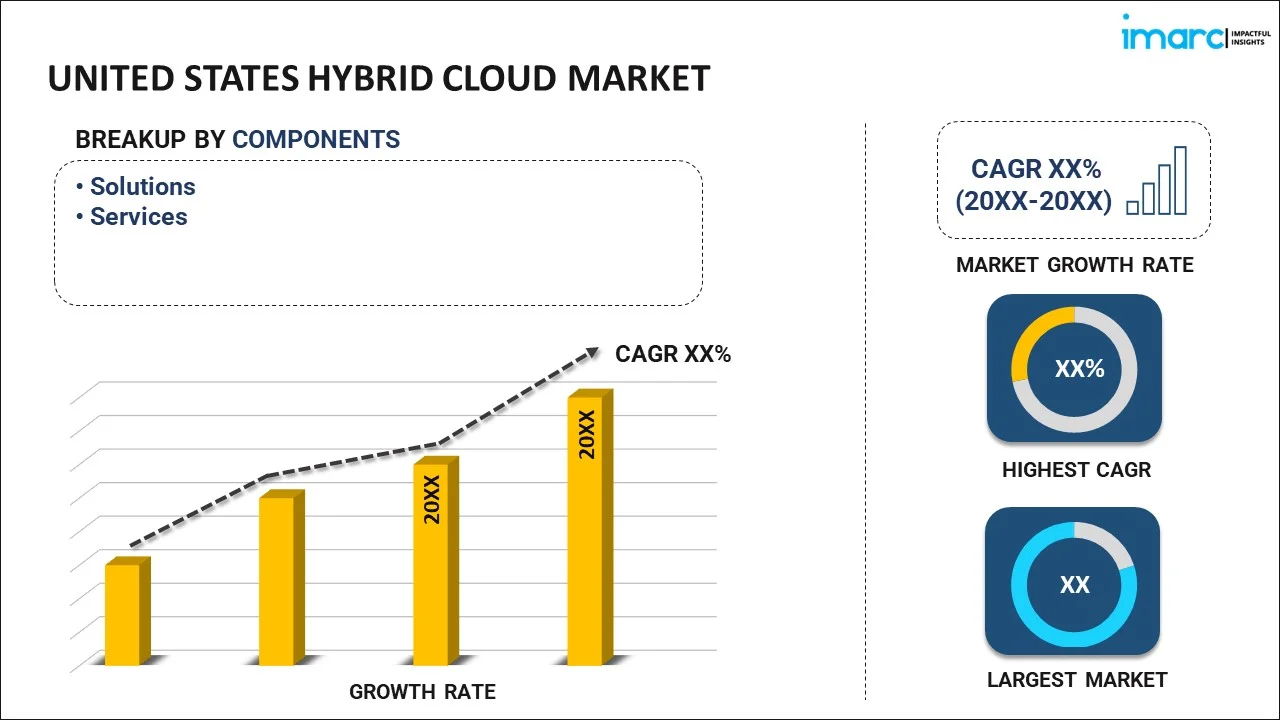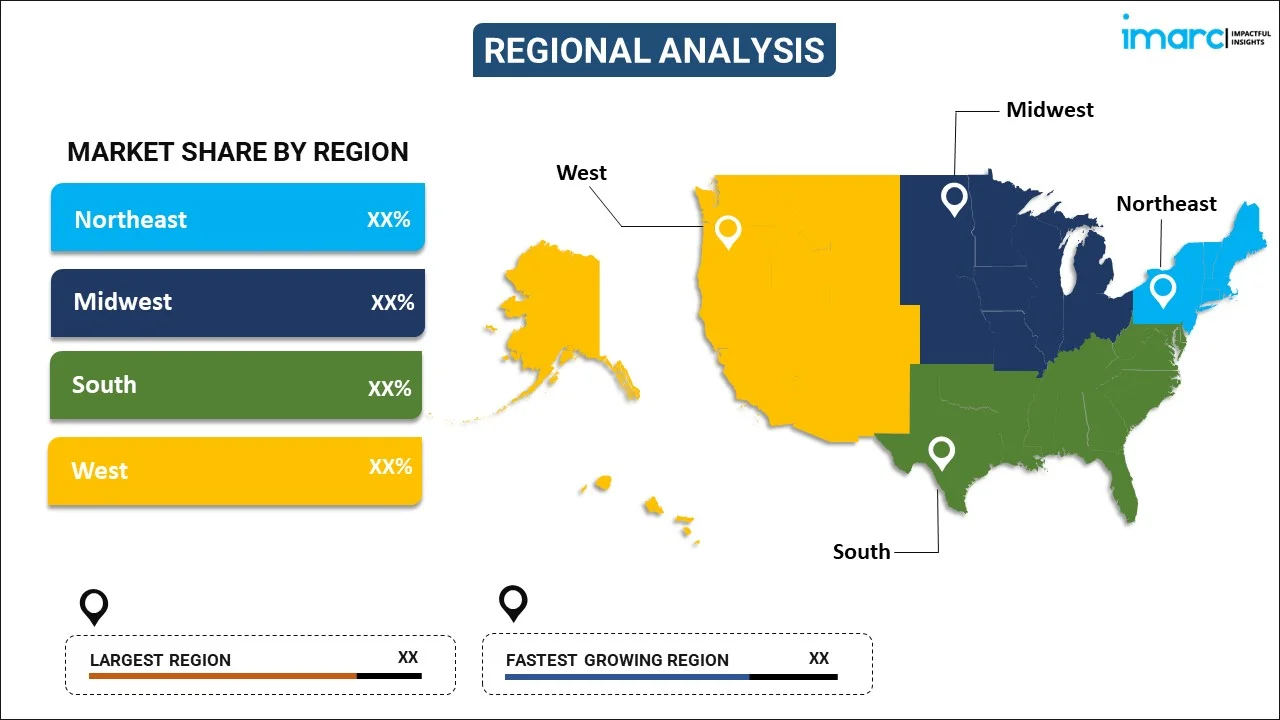
United States Hybrid Cloud Market Report by Component (Solutions, Services), Organization Size (Small Enterprises, Medium Enterprises, Large Enterprises), Vertical (Government and Public Sector, Healthcare, Banking, Finance, Services, and Insurance (BFSI), Retail, Information and Communication Technology, Manufacturing, and Others), and Region 2024-2032
Market Overview:
United States hybrid cloud market size reached US$ 39.9 Billion in 2023. Looking forward, IMARC Group expects the market to reach US$ 157.7 Billion by 2032, exhibiting a growth rate (CAGR) of 16.5% during 2024-2032. The growing focus on modernizing information technology (IT) infrastructure and enabling digital innovation, rising need to manage the Internet of Things (IoT) data, and increasing remote work culture represent some of the key factors driving the market.
|
Report Attribute
|
Key Statistics
|
|---|---|
|
Base Year
|
2023
|
|
Forecast Years
|
2024-2032
|
|
Historical Years
|
2018-2023
|
|
Market Size in 2023
|
US$ 39.9 Billion |
|
Market Forecast in 2032
|
US$ 157.7 Billion |
| Market Growth Rate 2024-2032 | 16.5% |
A hybrid cloud is a dynamic computing environment that combines characteristics of both public and private clouds to provide organizations with enhanced flexibility and scalability. It allows data and applications to move seamlessly between on-premises infrastructure, a private cloud, and public cloud services, creating a flexible and versatile computing environment. It enables companies to optimize costs by using public cloud resources for non-sensitive workloads and reserving private cloud resources for mission-critical operations. It allows organizations to meet compliance standards while leveraging cloud benefits. It enables employees to access data and applications from anywhere, facilitating remote work. It also allows for quick allocation of computing power, storage, and other resources, ensuring that the infrastructure can adapt to workload variations. It offers improved disaster recovery solutions and enables organizations to back up data and applications in one environment and recover them in another in case of a failure or outage. It provides enhanced control over sensitive data and allows organizations to scale resources up or down as needed. As it assists in addressing data security and compliance requirements, the demand for hybrid cloud is rising in the United States.
United States Hybrid Cloud Market Trends:
The increasing utilization of hybrid cloud solutions to modernize information technology (IT) infrastructure and enable digital innovation currently represents one of the primary factors impelling the market growth in the United States. In line with this, the escalating demand for scalable and flexible IT environments on account of the rising remote work culture is positively influencing the market in the country. Additionally, the increasing adoption of hybrid cloud, as it offers efficient data management and storage options, is supporting the growth of the market in the US. Apart from this, there is a rise in the demand for cost-effective IT solutions in organizations. This, coupled with the increasing employment of hybrid cloud, as it provides advanced solutions for data backup and recovery during disaster, is strengthening the market growth in the country. Besides this, advanced data analytics and machine learning (ML) require scalable storage resources, which is propelling the market growth. In addition, the rising need to manage the Internet of Things (IoT) data is offering lucrative growth opportunities to industry investors. Furthermore, the growing demand for hybrid cloud solutions with enhanced security features and compliance capabilities to prevent financial losses, along with the increasing adoption of development and operations (DevOps) practices and continuous integration or continuous deployment (CI/CD), is offering a positive market outlook in the country.
United States Hybrid Cloud Market Segmentation:
IMARC Group provides an analysis of the key trends in each segment of the market, along with forecasts at the country level for 2024-2032. Our report has categorized the market based on component, organization size, and vertical.
Component Insights:

- Solutions
- Services
- Professional Services
- Managed Services
The report has provided a detailed breakup and analysis of the market based on the component. This includes solutions and services (professional services and managed services).
Organization Size Insights:
- Small Enterprises
- Medium Enterprises
- Large Enterprises
A detailed breakup and analysis of the market based on the organization size have also been provided in the report. This includes small enterprises, medium enterprises, and large enterprises.
Vertical Insights:
- Government and Public Sector
- Healthcare
- Banking, Finance, Services, and Insurance (BFSI)
- Retail
- Information and Communication Technology
- Manufacturing
- Others
The report has provided a detailed breakup and analysis of the market based on the vertical. This includes government and public sector, healthcare, banking, finance, services, and insurance (BFSI), retail, information and communication technology, manufacturing, and others.
Regional Insights:

- Northeast
- Midwest
- South
- West
The report has also provided a comprehensive analysis of all the major regional markets, which include Northeast, Midwest, South, and West.
Competitive Landscape:
The market research report has also provided a comprehensive analysis of the competitive landscape in the market. Competitive analysis such as market structure, key player positioning, top winning strategies, competitive dashboard, and company evaluation quadrant has been covered in the report. Also, detailed profiles of all major companies have been provided.
United States Hybrid Cloud Market Report Coverage:
| Report Features | Details |
|---|---|
| Base Year of the Analysis | 2023 |
| Historical Period | 2018-2023 |
| Forecast Period | 2024-2032 |
| Units | US$ Billion |
| Scope of the Report | Exploration of Historical and Forecast Trends, Industry Catalysts and Challenges, Segment-Wise Historical and Predictive Market Assessment:
|
| Components Covered |
|
| Organization Sizes Covered | Small Enterprises, Medium Enterprises, Large Enterprises |
| Verticals Covered | Government and Public Sector, Healthcare, Banking, Finance, Services, and Insurance (BFSI), Retail, Information and Communication Technology, Manufacturing, Others |
| Regions Covered | Northeast, Midwest, South, West |
| Customization Scope | 10% Free Customization |
| Report Price and Purchase Option | Single User License: US$ 3699 Five User License: US$ 4699 Corporate License: US$ 5699 |
| Post-Sale Analyst Support | 10-12 Weeks |
| Delivery Format | PDF and Excel through Email (We can also provide the editable version of the report in PPT/Word format on special request) |
Key Questions Answered in This Report:
- How has the United States hybrid cloud market performed so far and how will it perform in the coming years?
- What has been the impact of COVID-19 on the United States hybrid cloud market?
- What is the breakup of the United States hybrid cloud market on the basis of component?
- What is the breakup of the United States hybrid cloud market on the basis of organization size?
- What is the breakup of the United States hybrid cloud market on the basis of vertical?
- What are the various stages in the value chain of the United States hybrid cloud market?
- What are the key driving factors and challenges in the United States hybrid cloud?
- What is the structure of the United States hybrid cloud market and who are the key players?
- What is the degree of competition in the United States hybrid cloud market?
Key Benefits for Stakeholders:
- IMARC’s industry report offers a comprehensive quantitative analysis of various market segments, historical and current market trends, market forecasts, and dynamics of the United States hybrid cloud market from 2018-2032.
- The research report provides the latest information on the market drivers, challenges, and opportunities in the United States hybrid cloud market.
- Porter's five forces analysis assist stakeholders in assessing the impact of new entrants, competitive rivalry, supplier power, buyer power, and the threat of substitution. It helps stakeholders to analyze the level of competition within the United States hybrid cloud industry and its attractiveness.
- Competitive landscape allows stakeholders to understand their competitive environment and provides an insight into the current positions of key players in the market.
Need more help?
- Speak to our experienced analysts for insights on the current market scenarios.
- Include additional segments and countries to customize the report as per your requirement.
- Gain an unparalleled competitive advantage in your domain by understanding how to utilize the report and positively impacting your operations and revenue.
- For further assistance, please connect with our analysts.
 Inquire Before Buying
Inquire Before Buying
 Speak to an Analyst
Speak to an Analyst
 Request Brochure
Request Brochure
 Request Customization
Request Customization




.webp)




.webp)












